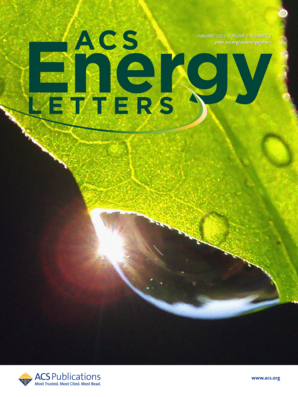Iodine Boosted Fluoro‐Organic Borate Electrolytes Enabling Fluent Ion‐conductive Solid Electrolyte Interphase for High‐Performance Magnesium Metal Batteries
IF 19.3
1区 材料科学
Q1 CHEMISTRY, PHYSICAL
引用次数: 0
Abstract
Rechargeable magnesium batteries are regarded as a promising multi‐valent battery system for low‐cost and sustainable energy storage applications. Boron‐based magnesium salts with terminal substituent fluorinated anions (Mg[B(ORF)4]2, RF = fluorinated alkyl) have exhibited impressive electrochemical stability. Nevertheless, their deployment is hindered by the complicated synthesis routes and the surface passivation of Mg anode. Herein, we report the design of an advanced electrolyte formulation comprised of B(HFIP)3 and I2 in 1,2‐dimethoxyethane (DME), which eventually convert into a Mg[B(HFIP)4]2/DME‐MgI2 electrolyte system upon interacting with Mg anode. The Mg anode reacts with I2 and the electron‐accepting B(HFIP)3, leading to the in‐situ formation of a solid‐electrolyte interphase layer composed of MgF2 and MgI2 species that can facilitate fast and stable Mg plating/stripping. Compared with the pristine Mg[B(HFIP)4]2/DME electrolyte, the Mg[B(HFIP)4]2/DME‐MgI2 electrolyte exhibited superior electrochemical performance including an ultra‐low overpotential (~80 mV), high Coulombic efficiency and a long‐cycling period over 1500 h. In result, the rechargeable magnesium batteries with Mg[B(HFIP)4]2/DME‐MgI2 electrolyte and Mo6S8 cathode show outstanding compatibility, rapid kinetics, and stable cyclability for over 1200 cycles, surpassing all previously reported boron‐based electrolytes. This work introduces a promising halogen‐enhancement strategy for boron‐based Mg‐ion electrolytes and is pivotal for the advancement and optimization of multi‐valent secondary batteries.碘促进氟有机硼酸盐电解质,为高性能金属镁电池提供氟离子导电固态电解质间相
可充电镁电池被认为是一种前景广阔的多价电池系统,可用于低成本和可持续的能源储存应用。具有末端取代基氟化阴离子(Mg[B(ORF)4]2,RF = 氟化烷基)的硼基镁盐表现出令人印象深刻的电化学稳定性。然而,复杂的合成路线和镁阳极的表面钝化阻碍了它们的应用。在此,我们报告了一种先进电解质配方的设计,该配方由 B(HFIP)3 和 I2 在 1,2-二甲氧基乙烷(DME)中组成,与镁阳极相互作用后最终转化为 Mg[B(HFIP)4]2/DME-MgI2 电解质体系。镁阳极与 I2 和电子接受性 B(HFIP)3 发生反应,从而在原位形成了由 MgF2 和 MgI2 组成的固态电解质间相层,这有助于快速稳定地镀镁/剥镁。与原始的 Mg[B(HFIP)4]2/DME 电解质相比,Mg[B(HFIP)4]2/DME-MgI2 电解质表现出卓越的电化学性能,包括超低过电位(约 80 mV)、高库仑效率和超过 1500 小时的长循环周期。因此,使用 Mg[B(HFIP)4]2/DME-MgI2 电解质和 Mo6S8 阴极的可充电镁电池具有出色的兼容性、快速动力学和超过 1200 次循环的稳定循环性,超过了之前报道的所有硼基电解质。这项工作为硼基镁离子电解质引入了一种前景广阔的卤素增强策略,对多价二次电池的发展和优化至关重要。
本文章由计算机程序翻译,如有差异,请以英文原文为准。
求助全文
约1分钟内获得全文
求助全文
来源期刊

ACS Energy Letters
Energy-Renewable Energy, Sustainability and the Environment
CiteScore
31.20
自引率
5.00%
发文量
469
审稿时长
1 months
期刊介绍:
ACS Energy Letters is a monthly journal that publishes papers reporting new scientific advances in energy research. The journal focuses on topics that are of interest to scientists working in the fundamental and applied sciences. Rapid publication is a central criterion for acceptance, and the journal is known for its quick publication times, with an average of 4-6 weeks from submission to web publication in As Soon As Publishable format.
ACS Energy Letters is ranked as the number one journal in the Web of Science Electrochemistry category. It also ranks within the top 10 journals for Physical Chemistry, Energy & Fuels, and Nanoscience & Nanotechnology.
The journal offers several types of articles, including Letters, Energy Express, Perspectives, Reviews, Editorials, Viewpoints and Energy Focus. Additionally, authors have the option to submit videos that summarize or support the information presented in a Perspective or Review article, which can be highlighted on the journal's website. ACS Energy Letters is abstracted and indexed in Chemical Abstracts Service/SciFinder, EBSCO-summon, PubMed, Web of Science, Scopus and Portico.
 求助内容:
求助内容: 应助结果提醒方式:
应助结果提醒方式:


